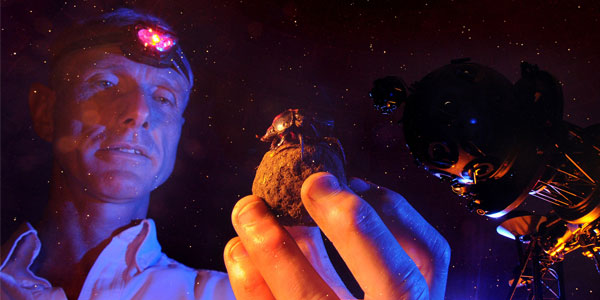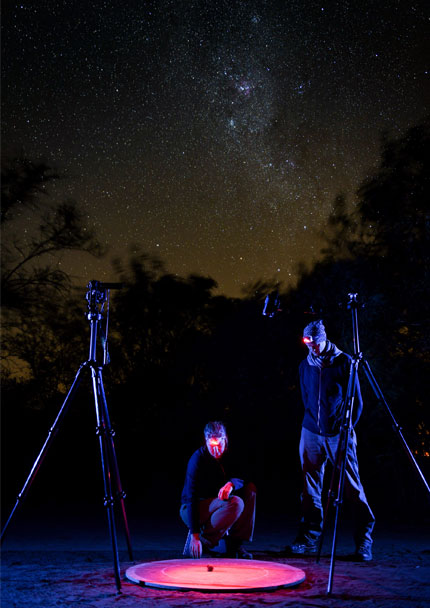Navigating life through the eyes of a gogga
- Pontsho Pilane
Curiosity about dung beetles could lead us into our future.

One day, 30 years ago, Wits entomologist Professor Marcus Byrne was standing in the African bushveld, curiously observing a dung beetle doing a little dance on a ball of dung. Then it set off, rolling the ball in a perfectly straight line into the distance.
The insect’s dance fascinated Byrne, who immediately started asking questions: What is the purpose of the dung beetle’s dance? How do dung beetles orientate themselves? How do they navigate and roll their ball in a perfectly straight line?
Byrne’s curiosity led to a 30-year study of this insect and changed not only what we know about these insects and how they navigate their world, but also led to new insights on how we can teach robots to navigate. It has attracted the attention of the US military, and led to a book, written by Byrne and Helen Lunn about human’s fascination with these insects over thousands of years, and their role in our changing lives.
“It turns out that the dung beetle’s ‘dance’ – standing on top of the ball of dung and spinning – is an orientation and navigation behaviour to determine the fastest and most efficient way to leave the dung pile to avoid a competitor’s hijacking of the ball of dung,” says Byrne.
“Dung beetles have almost no memory. Because elephant droppings are never at the same place, dung beetles don’t need to remember how to travel to and from a specific spot. However, they do need to know how to navigate to find their way around the bush.”
The beetles, it was found, use celestial cues –?among others – for orientation. In other words, they scan the sky for orientation cues. The dung beetle’s built-in navigation system is the key to its ability to roll balls of dung with precision during the day and night, even under the gruelling African sun.
Further experiments conducted inside the Wits Planetarium reveal that they can navigate using the Milky Way – making them the first species known to do so.
“We were able to prove that some species of dung beetles don’t just orientate, they do truly navigate. Orientation just means you're able to move in a straight line or move with intent. Whereas navigation means you're able to move between two known places on the surface of the planet,” Byrne explains.
Using an insect’s brain to develop robotics
Byrne and a team of scientists from Sweden, Germany, Australia and South Africa have since 2013 meticulously observed and run experiments on certain species of dung beetles with the hopes of using their discoveries about the beetles’ brains –?which are smaller than a grain of rice – in real-life applications in robotics and Artificial Intelligence.
A large part of the team’s research has looked at what they've called a “dung beetle compass”. They started off with experiments that looked at how dung beetles use the sun to navigate. They then went on to understand how the insects used polarised light as a navigational aid, then the moon and even the wind.
 “The dung beetles’ ability to use directional sensors to achieve navigational precision opens possibilities for us to understand how their minuscule brains are able to handle large amounts of information, which allow them to go in a certain direction,” says Byrne.
“The dung beetles’ ability to use directional sensors to achieve navigational precision opens possibilities for us to understand how their minuscule brains are able to handle large amounts of information, which allow them to go in a certain direction,” says Byrne.
In theory, the discoveries and understanding of dung beetles’ brains could help scientists build robots that are autonomous and don’t need a pilot or map to drive them through unknown terrain.
“Roboticists are interested in understanding dung beetles’ simple directional cues and their ability to use the sun, moon, stars, wind, and polarised lights to feed the same algorithm into robots to increase their efficiency,” Byrne says.
Thousands of years of fascination
Globally, there are around 6 000 species of dung beetles and Africa is home to about 2 000 of them, with more than 800 of those species in SA. But only 10% of these animals roll the dung into a ball – often across the hot African continent.
Dung beetles have fascinated humans for thousands of years. As described in Byrne’s book, Dance of the Dung Beetles: Their role in our changing world, these night-soil collectors of the planet have been worshipped as gods, worn as jewellery and painted by artists.
More practically, they saved Hawaii from ecological blight and rescued Australia from plagues of flies. They fertilise soil, cleanse pastures, steer by the stars, and have a unique relationship with the African elephant.?Now, they will also influence the way we train robots.
While humans may admire dung beetles, our own advancements and actions threaten their existence. Last year, Byrne and his team found that light pollution - from the myriad manmade light sources - makes it difficult for dung beetles to find their way. Large amounts of unnatural light cause the night sky to glow unnaturally bright, leaving only the brightest stars visible.
“Given the level of light pollution in the modern world, we wondered how ‘sky glow’ in the night skies of our cities would affect the ability of dung beetles to orientate themselves.”
The experiments showed the presence of unnatural light makes it impossible for the dung beetles to use the stars for orientation and navigation like they typically would.
Beyond the discoveries and exciting future possibilities, Byrne says that this body of work is curiosity at its highest form.
“The core of being human is to ask questions and to be curious about the world around us. Curiosity is part of what we are as humans. Curiosity allows us to question the world around us, without having to justify it in any other way other than to satisfy our curiosity,” he says.
- Pontsho Pilane is a freelance writer.
- This article first appeared in?Curiosity, a research magazine produced by?Wits Communications?and the?Research Office. Read more in the 14th issue, themed: #足球竞彩app排名 where we celebrate a century of research excellence that has shaped today and look forward to how our next-generation researchers will impact the next 100 years.

